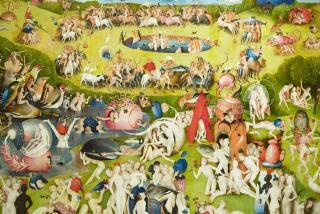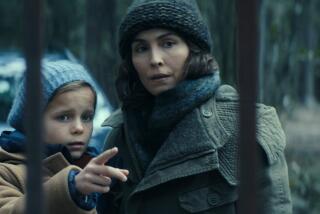Review: Befores, afters and in betweens fuel ‘Dead Astronauts’
The final pages of Jeff VanderMeer’s “Dead Astronauts” tie everything together, making sense of what came before.
But first, readers land in a dystopia populated by impossible creatures: a disappearing blue fox, a carnivorous duck with a broken wing, attack beetles, a deadly underwater behemoth, a coordinated swarm of salamanders. And the astronauts of the title, although when we meet them they are not dead yet.
This will all be familiar to readers of 2017’s “Borne,” in which VanderMeer introduced us to this richly imagined world, or last year’s addition, “The Strange Bird.” Having read those books isn’t required to understand this one — in “Borne,” the dead astronauts are simply window dressing, a trio of dusty spacesuits that serve as a landmark in the desert landscape.
Here, they are very much alive: Chen, Moss and Grayson land near the City, with an unstated mission taking them to the Company on its outskirts. The Company is a complex where some kind of bioengineering took place, but that was long ago. The City, the Company, the space in between — all are in ruins. How they got that way is played out in the book.
In that, “Dead Astronauts” serves as a kind of backstory to “Borne,” explaining how this world came to be. But linear time is disrupted here. What first seems to be a single timeline jumps to several, to 10, maybe more. The before of one timeline doesn’t match up with the after of another. Maybe it’s best to think of it as a multiverse, folded; there are multiple versions of what the astronauts find.
“The Company always looked basically the same; whether an enormous white egg or a vast gray triangle or a ziggurat of series of spires, like a fractured cathedral. Holding ponds of biotech rejects always hunched up against the side, a convenient hell or purgatory, full of dying life, then lines of invisible defenses across the wasteland beyond.”
The astronauts hope to get inside the Company complex, where they might (or might not) find a man they call Charlie X. There are many unknowns — whether he is there, alive, sane. What is certain is that he was at least in part responsible for setting all the strange hybrids out into the world. Chen once worked for him. Moss was held captive by him.
The astronauts are trying, the best they can, to battle evil: Charlie X, the forces behind him and the bloodthirsty creatures he has unleashed. We know from the title what fate awaits them; what’s a surprise is that we eventually start getting the points of view of the killer creatures too.
VanderMeer, whose imaginative novels are fed by his fecund home state of Florida, wants us to inhabit the minds of his ravenous bird and the massive fish held in a tank. It’s actually not that far off from the world we know — and perhaps that’s the point. Who hasn’t wondered what it’s like to be a bird swooping from the sky? These monsters become less monstrous when we live inside their (often hungry, often angry) heads.
The astronauts may be outmatched, but at least they are in sync with each other. They do, however, have trouble staying connected to the world around them. Sometimes their awareness fractures, dissolves on the page. We get one point of view, then another, often increasingly tenuous. Perhaps some of what they relate is meant to be less of an objective reality than the psychic symptoms of their slipping away.
A third of the way through the book, VanderMeer begins including passages that are numbered in the margins. They count backward and down, not in a single sequence but a series of versions, always in reverse order. He’s trying to show us that the narrative is bringing us back to its beginning.
The marginalia is not the only formal invention. Some pages are blank but for short passages of text. In the space, there is silence. In other places, phrases repeat and repeat and repeat for pages. Some text appears in a lighter font — it could be the thoughts of a homeless woman, the memories she’s writing down in a notebook, or both.
She appears near the origin, when the City and Company were in a world not unlike our own. She lives under a bridge, and a strip mall nearby is tagged by spray paint. She’s afraid of other people, is aware of high degrees of pollution and is lost to herself. On the page, she appears simply as “you” and then later as “the girl.”
After she finds a partially filled journal, it changes her. She begins to write in its blank pages. And she tries to mimic its writings, even if she can’t understand them. The journal appears to have magical properties; others seem to be searching for it. Readers will recognize it as having come from far in the future of her world — or possibly the future in a parallel version.
When writers are working in a series, there is a risk that its world will close in on itself. This world began with “Borne,” the story of a woman living in a broken-down apartment building in the City who finds a cuttlefish-slash-houseplant with the awareness of a little boy.
With “Dead Astronauts,” VanderMeer has expanded to a multiverse with a poisoned past, engineered monsters and a possibly redeemable future, all from something that was merely decoration. There’s no limit to where it might go next.
Jeff VanderMeer
MCD/Farrar, Straus and Giroux: 336 pages, $27
Kellogg is a former Times books editor and is currently a vice president of the National Book Critics Circle. She’s on Twitter @paperhaus.
More to Read
Sign up for our Book Club newsletter
Get the latest news, events and more from the Los Angeles Times Book Club, and help us get L.A. reading and talking.
You may occasionally receive promotional content from the Los Angeles Times.







